GSNadmin
Staff member
For several years now I have been highlighting my projects and workshop builds online to share some of my building tips and Techniques I use. In the long view, I have always thought that learning how to fly RC planes was a lot harder that the actual building of the planes, even when kit-building. MAN readers are always asking what is needed to produce the airplanes so I’ve highlighted some of the basics here. So, let’s take a look backstage to see what I use in my hobby workshop.
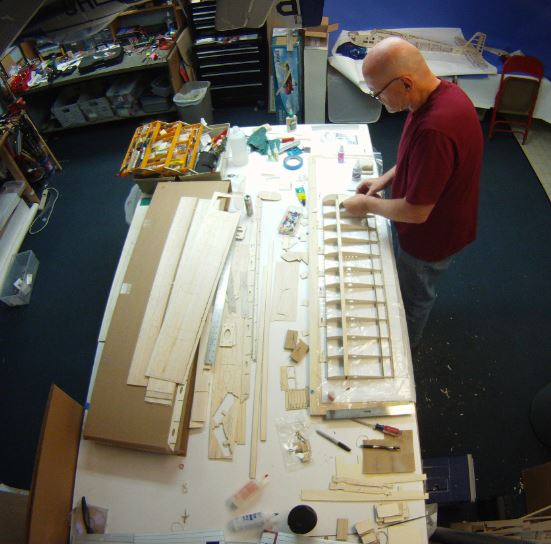
(Above) A workshop is what you make it. From a basic table to custom built-in cabinets and shelves, you want a special place to work on your planes.
If you have a spare room, or an unused garage bay, you have the space, and an old table is all you really need for a workbench. Take the time and with practice, your building skills will improve with each airplane you build. Like anything else, learning what’s involved is the first step and becoming an experienced modeler is really just applying new techniques that you’ve already learned. Start with a simple plane and in no time you’ll become get the hang of it.
Here are some of the basics I have picked up along the way.
Building Boards
I do not build directly on my workbench. I use a building board with a cork top surface. It is called a Wright Building Board. You can also use a piece of 2-inch foam insulation foam board or even a ceiling tile. These surfaces make pushing modeling pins into the parts to hold them on place ease. The important thing is to keep your building surface flat and straight. My WrightFlyer building board is made from particle board under the ½ inch cork top with aluminum angle pieces under it to keep it straight. It is about 48 inches long by 20 inches wide.
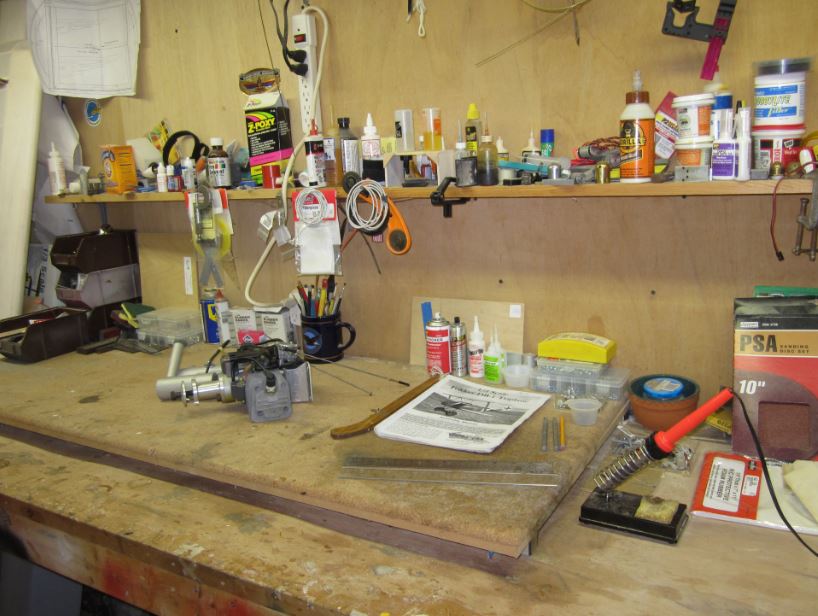
(Above) I used a raised cork covered building board for most of my building. It is much straighter and level than my workbench so makes straighter models.
If you use inslulation foam boards you can spray it lightly with some 3M spray adhesive to affix it to the top of your workbench and keep it straight. Just use a little bit so when it get worn out and needs to be replaced, you can pop it up with a long knife or a saw blade.
Also, don’t actually cut things on the building surface. I built my workbench so it was about 8 to 10 inches wider so there is a wood surface to use as a cutting and work surface. Keep the building board clean and neat and it will last a long time.
Plans protection
OK the plans should be flattened out and placed on the building board. I cut the plans apart into sections so only the part of the plans I need is used and I tape it in place. (you can also use a craft glue stick for this.) I then protect the plans from the glue with either some clear “Plans Protector” from Great Planes (less than $10 for 25 feet.) You can also use clear MonoKote of even the clear backing sheet from regular Monokote covering material. The Plans Protector by far works the best even with thin CA glues. Using the Plans Protector also cuts down on the sanding of parts. The adhesive will smooth out and there’s no paper glued to the parts that has to be removed for a smooth covering job later on.

A common problem with all modelers, no matter how neat you might think you are is “hangar rash”. Dents, cuts and dings caused by placing wood parts and structures on top of hard things like pins, screws, nuts etc. So what I try to do (and believe me, this is by no means easy,) is to clean up scrap and waste from work secessions right when I complete them. It is a bit much to do this after every single task, but when you call it quits for the evening, stop and clean up everything. Put the tools away and sweep up the dust and chips. If you don’t do this, the amount of time needed to “fix” hangar rash is always greater than the cleanup effort.

(Above) use a glue caddy to prevent spills on your workbench.
Stay organized
Finally, divide your building secessions so you have only the parts and tools you need for the task at hand. If you are building the wing, no need to have formers or fuselage sides and engine mounts on the bench getting in the way. I also like this approach as it gives you that accomplishment feeling quicker.

(Above) Organize all your hardware to make them easy to find. This saves building time and prevents hangar rash. RTL Fasteners (www.rtlfasteners.com) have lots of excellent hardware and handy organizer boxes.
I look at any model project as a series of smaller, minor assembly tasks or mini projects. This keeps the motivation up and you don’t get dragged down by thinking you have 75 or 80 percent of the plane to finish. I take 10 percent of the whole and finish it before moving onto the next 10 or 15 percent of the whole. It works for me anyway.
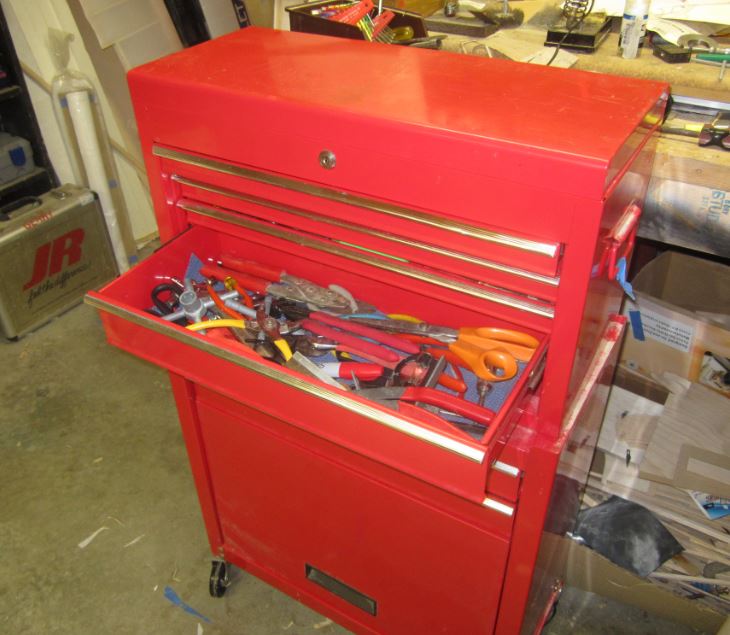
(Above) I could not live without my roll-away tool boxes. Keeping tools safe and handy is protecting your investment and helps save time.
Another good thing to do if you have the room is to have utility benches or tables where you have larger tools like sanders, drill presses or bandsaws located. This keeps your immediate work area cleaner and less crowded.
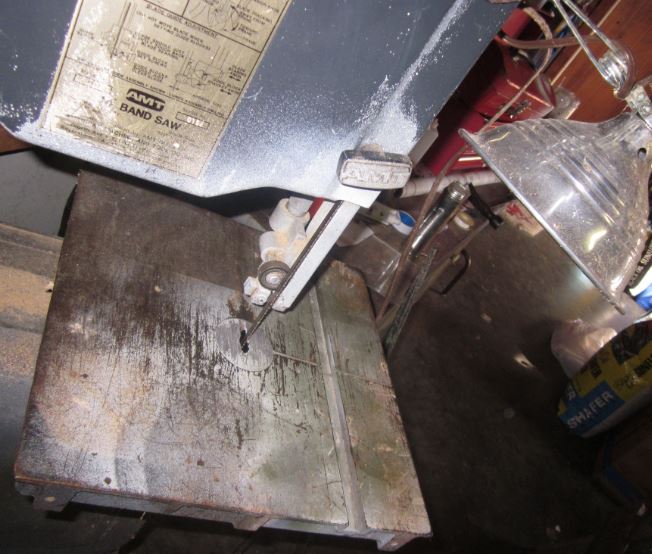
(Above) When ever using power tools like this 14 inch bandsaw, always provide plenty of light so you can see what you are doing.
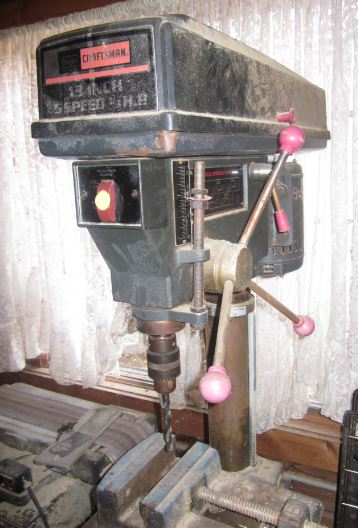
(Above) A drill press should be in every workshop. Add a machine vise to hold your parts and you can increase your precision 5 fold.

(Above) The biggest dust maker is the belt sander. I keep it away from the model workshop and have it in my garage. Always use a shop vac to collect the fine dust
It is true that you can build any model with just hand tools but for me, the investment in basic power tools is a good thing because they speed work and increase accuracy. Plus, you can use them for non-hobby related tasks as well.
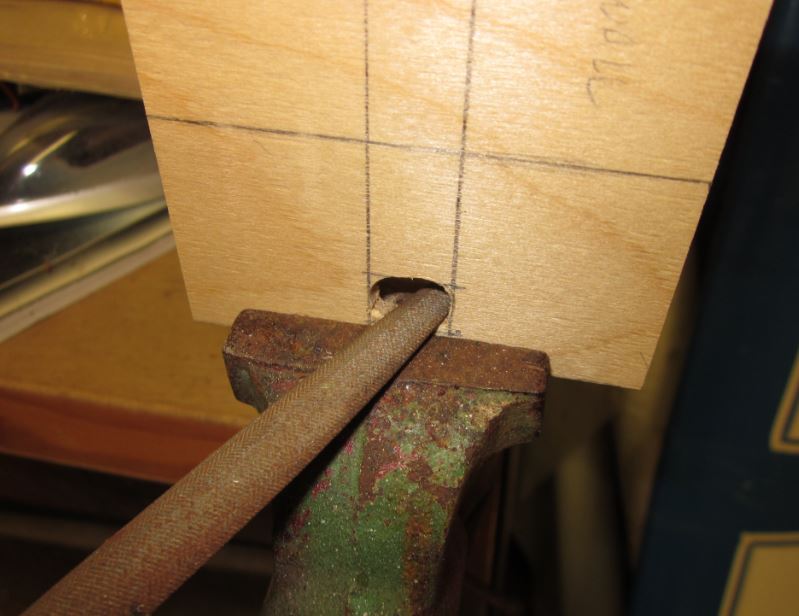
(Above) Nothing beats a good bench vice for holding parts while your work on them. This small vise has a clamp mount so it is portable and can slip over the edge of a table or workbench.
Finally, start with the more simple tasks and then work up to the bigger more involved ones and before you know it, your model will be built and ready to cover and finish… But that’s another article.

Model Airplane News - The #1 resource for RC plane and helicopter enthusiasts featuring news, videos, product releases and tech tips.
Continue reading...

(Above) A workshop is what you make it. From a basic table to custom built-in cabinets and shelves, you want a special place to work on your planes.
If you have a spare room, or an unused garage bay, you have the space, and an old table is all you really need for a workbench. Take the time and with practice, your building skills will improve with each airplane you build. Like anything else, learning what’s involved is the first step and becoming an experienced modeler is really just applying new techniques that you’ve already learned. Start with a simple plane and in no time you’ll become get the hang of it.
Here are some of the basics I have picked up along the way.
Building Boards
I do not build directly on my workbench. I use a building board with a cork top surface. It is called a Wright Building Board. You can also use a piece of 2-inch foam insulation foam board or even a ceiling tile. These surfaces make pushing modeling pins into the parts to hold them on place ease. The important thing is to keep your building surface flat and straight. My WrightFlyer building board is made from particle board under the ½ inch cork top with aluminum angle pieces under it to keep it straight. It is about 48 inches long by 20 inches wide.

(Above) I used a raised cork covered building board for most of my building. It is much straighter and level than my workbench so makes straighter models.
If you use inslulation foam boards you can spray it lightly with some 3M spray adhesive to affix it to the top of your workbench and keep it straight. Just use a little bit so when it get worn out and needs to be replaced, you can pop it up with a long knife or a saw blade.
Also, don’t actually cut things on the building surface. I built my workbench so it was about 8 to 10 inches wider so there is a wood surface to use as a cutting and work surface. Keep the building board clean and neat and it will last a long time.
Plans protection
OK the plans should be flattened out and placed on the building board. I cut the plans apart into sections so only the part of the plans I need is used and I tape it in place. (you can also use a craft glue stick for this.) I then protect the plans from the glue with either some clear “Plans Protector” from Great Planes (less than $10 for 25 feet.) You can also use clear MonoKote of even the clear backing sheet from regular Monokote covering material. The Plans Protector by far works the best even with thin CA glues. Using the Plans Protector also cuts down on the sanding of parts. The adhesive will smooth out and there’s no paper glued to the parts that has to be removed for a smooth covering job later on.

A common problem with all modelers, no matter how neat you might think you are is “hangar rash”. Dents, cuts and dings caused by placing wood parts and structures on top of hard things like pins, screws, nuts etc. So what I try to do (and believe me, this is by no means easy,) is to clean up scrap and waste from work secessions right when I complete them. It is a bit much to do this after every single task, but when you call it quits for the evening, stop and clean up everything. Put the tools away and sweep up the dust and chips. If you don’t do this, the amount of time needed to “fix” hangar rash is always greater than the cleanup effort.

(Above) use a glue caddy to prevent spills on your workbench.
Stay organized
Finally, divide your building secessions so you have only the parts and tools you need for the task at hand. If you are building the wing, no need to have formers or fuselage sides and engine mounts on the bench getting in the way. I also like this approach as it gives you that accomplishment feeling quicker.

(Above) Organize all your hardware to make them easy to find. This saves building time and prevents hangar rash. RTL Fasteners (www.rtlfasteners.com) have lots of excellent hardware and handy organizer boxes.
I look at any model project as a series of smaller, minor assembly tasks or mini projects. This keeps the motivation up and you don’t get dragged down by thinking you have 75 or 80 percent of the plane to finish. I take 10 percent of the whole and finish it before moving onto the next 10 or 15 percent of the whole. It works for me anyway.

(Above) I could not live without my roll-away tool boxes. Keeping tools safe and handy is protecting your investment and helps save time.
Another good thing to do if you have the room is to have utility benches or tables where you have larger tools like sanders, drill presses or bandsaws located. This keeps your immediate work area cleaner and less crowded.

(Above) When ever using power tools like this 14 inch bandsaw, always provide plenty of light so you can see what you are doing.

(Above) A drill press should be in every workshop. Add a machine vise to hold your parts and you can increase your precision 5 fold.

(Above) The biggest dust maker is the belt sander. I keep it away from the model workshop and have it in my garage. Always use a shop vac to collect the fine dust
It is true that you can build any model with just hand tools but for me, the investment in basic power tools is a good thing because they speed work and increase accuracy. Plus, you can use them for non-hobby related tasks as well.

(Above) Nothing beats a good bench vice for holding parts while your work on them. This small vise has a clamp mount so it is portable and can slip over the edge of a table or workbench.
Finally, start with the more simple tasks and then work up to the bigger more involved ones and before you know it, your model will be built and ready to cover and finish… But that’s another article.

Model Airplane News - The #1 resource for RC plane and helicopter enthusiasts featuring news, videos, product releases and tech tips.
Continue reading...
